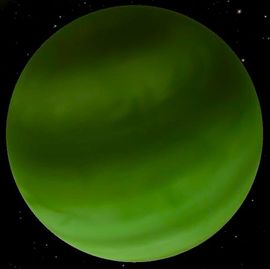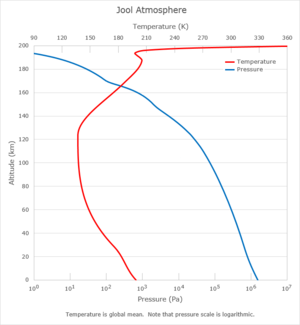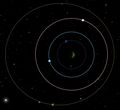Difference between revisions of "Jool"
m (Reverted edits by Rocketing Rudolph (talk) to last revision by Asdfghjkl) |
m (→In-game description) |
||
| Line 6: | Line 6: | ||
{{Quote | {{Quote | ||
| − | + | |Jool is particularly known for being a rather large, predominantly green planet. Kerbalkind has longed to visit it since it was first spotted in the sky. Philosophers reason that the swirling green planet must be a really nice place to visit, on account of its wholesome coloration.<br /> | |
| − | |Jool is particularly known for being a rather large, predominantly green planet. | + | <br /> |
| − | + | If you look at Jool through a telescope, it is fuzzy. | |
|[[Kerbal Astronomical Society]]}} | |[[Kerbal Astronomical Society]]}} | ||
Revision as of 18:54, 27 May 2017
| Jool | ||
| Jool as seen from orbit. | ||
| Planet of Kerbol | ||
| Orbital Characteristics | ||
| Semi-major axis | 68 773 560 320 m [Note 1] | |
| Apoapsis | 72 212 238 387 m [Note 1] | |
| Periapsis | 65 334 882 253 m [Note 1] | |
| Orbital eccentricity | 0.05 | |
| Orbital inclination | 1.304 ° | |
| Argument of periapsis | 0 ° | |
| Longitude of the ascending node | 52 ° | |
| Mean anomaly | 0.1 rad (at 0s UT) | |
| Sidereal orbital period | 104 661 432 s | |
| 4 845 d 2 h 37 m 12.1 s | ||
| Synodic orbital period | 10 090 901.7 s | |
| Orbital velocity | 3 927 - 4 341 m/s | |
| Physical Characteristics | ||
| Equatorial radius | 6 000 000 m | |
| Equatorial circumference | 37 699 112 m | |
| Surface area | 4.5238934×1014 m2 | |
| Mass | 4.2332127×1024 kg | |
| Standard gravitational parameter | 2.8252800×1014 m3/s2 | |
| Density | 4 678.7273 kg/m3 | |
| Surface gravity | 7.85 m/s2 (0.8 g) | |
| Escape velocity | 9 704.43 m/s | |
| Sidereal rotation period | 36 000.000 s | |
| 1 d 4 h 0 m 0 s | ||
| Solar day | 36 012.387 s | |
| 1 d 4 h 0 m 12.4 s | ||
| Sidereal rotational velocity | 1 047.2 m/s | |
| Synchronous orbit | 15 010.46 km | |
| Sphere of influence | 2.4559852×109 m [Note 1] | |
| Atmospheric Characteristics | ||
| Atmosphere present | Yes | |
| Atmospheric pressure | 1 519.88 kPa | |
| 15 atm | ||
| Atmospheric height | 200 000 m | |
| 1.5×10-5 atm | ||
| Temperaturemin | -153.14 °C 120.01 K | |
| Temperaturemax | -48.08 °C 225.07 K | |
| Oxygen present | No | |
| Scientific multiplier | ||
| Surface | N/A | |
| Splashed | N/A | |
| Lower atmosphere | 12 | |
| Upper atmosphere | 9 | |
| Near space | 7 | |
| Outer space | 6 | |
| Recovery | 6 | |
|
| ||
Jool is a gas giant and the sixth planet of the Kerbol star system. It is the Jupiter analog for Kerbal Space Program. Aside from Kerbol, Jool has the largest diameter and greatest mass of all celestial bodies. While its distance from Kerbin makes it difficult to reach, it is one of the most appealing targets for missions due to its large and complex system of five moons: Laythe, Vall, Tylo, Bop, and Pol. It was possible to land and plant flags on Jool[1] before v0.23. In versions following 0.23, the craft won't stop at an altitude of -100 m, instead it will continue descending until it gets to -250 m. At this point, anything that hits this altitude at any speed will be completely destroyed.
Contents
In-game description
| “ | Jool is particularly known for being a rather large, predominantly green planet. Kerbalkind has longed to visit it since it was first spotted in the sky. Philosophers reason that the swirling green planet must be a really nice place to visit, on account of its wholesome coloration.
|
” |
Atmosphere
Jool has an extremely dense, cold atmosphere with a mass of approximately 8.8×1019 kilograms, a datum level pressure of 1519.875 kilopascals (15 atmospheres), and a depth of 200,000 meters. Compared to the atmosphere of Kerbin, Jool's atmosphere has 1875 times the mass, 15 times the surface pressure, and nearly 3 times the depth. At an altitude of 91,554 m on Jool, the atmospheric pressure is the same as at sea level on Kerbin (1 atm).
The average molecular weight of Jool air is 2.2 g/mol, and its adiabatic index is 1.43. Although the composition of Jool's atmosphere is unknown, these values suggest that it consists mostly of hydrogen and helium. The molar mass of Jool's atmosphere is comparable to the real life planet Jupiter. Because of the low molar weight, Jool air at the datum level is only about 2 times as dense as Kerbin air at sea level.
Like all other atmospheres in the game, Jool's atmosphere fades exponentially as altitude increases. The scale height varies with altitude, which is a change from pre-1.0 versions of the game. The pressure-altitude profile is globally constant and independent of temperature. The following table gives the atmospheric pressure at various altitudes above the datum level.
| Altitude (m) | Pressure (Pa) | Pressure (atm) |
|---|---|---|
| 0 | 1 519 875 | 15.000 |
| 10 000 | 1 060 650 | 10.468 |
| 20 000 | 783 625 | 7.734 |
| 30 000 | 613 670 | 6.056 |
| 40 000 | 482 628 | 4.763 |
| 50 000 | 373 138 | 3.683 |
| 60 000 | 283 031 | 2.793 |
| 70 000 | 210 136 | 2.074 |
| 80 000 | 152 282 | 1.503 |
| 90 000 | 107 299 | 1.059 |
| 100 000 | 73 016 | 0.721 |
| 110 000 | 47 263 | 0.466 |
| 120 000 | 27 869 | 0.275 |
| 130 000 | 13 529 | 0.134 |
| 140 000 | 5 319 | 0.052 |
| 150 000 | 2 000 | 0.020 |
| 160 000 | 734.7 | 0.007 |
| 170 000 | 100.0 | 0.001 |
| 180 000 | 29.57 | 0.000 |
| 190 000 | 3.675 | 0.000 |
| 200 000 | 0 | 0.000 |
Air temperatures decrease as altitude increases up to an elevation of about 123 km, were the coldest atmospheric temperatures are found. A gradual warming begins above 123 km. At an altitude of 194 km there begins a very rapid increase in temperature, suggesting the presence of a thermosphere.
Air temperatures vary with latitude and time of day. At the datum level (elevation = 0) the temperature is a globally constant -73 °C. As the altitude increases, latitudinal and diurnal temperature variations are observed, becoming more pronounced with increasing altitude. At an altitude of 123.45 km, temperatures at the equator vary between a nighttime low of -129 °C and a daytime high of -122 °C. At this same altitude over the poles, the temperature varies between -185 °C and -181 °C. Since Jool has no axial tilt, there are no seasonal temperature variations.
Atmospheric flight
Since version 1.0.5, Jool's atmosphere is well suited for aerocapture from a high-speed interplanetary intercept. The periapsis altitude required for a successful aerocapture depends on the spacecraft's drag characteristics, its approach velocity, and the desired apoapsis of the resulting orbit. The most effective periapsis for aerocapture is best determined experimentally; however, for a Hohmann transfer originating from Kerbin, it is found that the median value is about 155 km. A Heat shield is required to prevent destructive overheating.
Parachutes work very effectively in Jool's dense atmosphere. However, even without parachutes, a craft can reach a relatively low speed, depending on the shape of the ship, as well as its mass.
Jool has no solid surface to land on; descending spacecraft will explode when they reach the altitude of -250 m. The message "... collided with Cloud" will be displayed in the mission summary. The game may glitch out and corrupt the save. Prior to version 0.23, it was possible to land on a solid surface, though spacecraft were inevitably and invariably devoured by the Kraken.
If a kerbonaut is put on EVA, they will not be destroyed immediately, making one-way sacrificial "landings" possible. However this Kerbal will definitely die, and other glitches may occur, such as the Hell Kraken.
Reference frames
| Time warp | Minimum Altitude |
|---|---|
| 1× | Any |
| 5× | 200 000 m (above the atmosphere) |
| 10× | 200 000 m (above the atmosphere) |
| 50× | 200 000 m (above the atmosphere) |
| 100× | 200 000 m (above the atmosphere) |
| 1 000× | 300 000 m |
| 10 000× | 600 000 m |
| 100 000× | 1 200 000 m |
Natural satellites
 The ocean moon Laythe, about to transit Jool. Jool has five natural satellites, each with an orbit well-aligned with Jool's orbital plane:
Laythe, Vall, and Tylo are in what appears to be a Laplace resonance, with orbital periods of 1:2:4 respectively. Actual lineup is not the same, resulting in what would be a highly unstable resonance if the moons were not on rails. Despite the fact that the moons can easily eclipse both each other and Jool, they do not. Synchronous Orbits around any of the Joolian moons are impossible, as they all lie outside the Sphere of Influence of the moons, as is common with tidally locked bodies. |
Gallery
- → See also: Images of Jool
Trivia
- Jool has roughly the same equatorial radius as the planets Earth and Venus.
- The sunsets and sunrises on Jool are a shade of yellowish brown.
- Like Jool's moons, Jupiter's three nearest moons, Io, Europa, and Ganymede, have relative orbital periods of 1:2:4. Unlike Jool's, Jupiters have differing arguments that result in a true Laplace resonance.
- Interestingly, if you use an N-Body simulation, the Jool system is very unstable and will rapidly collapse into a radically different system. Vall gets thrown out into interplanetary space, as do Pol and Bop, and Laythe and Tylo become closer together. In order to solve this problem, the moons must be broken out of resonance, or Jool's mass must be drastically increased.
- Jool, Laythe and Tylo all have a surface gravity of 7.85 m/s² (≃ 0.8 g)
- The green gas which composes Jool could be chlorine.
- Despite not having a surface, the game files that contain what the Kerbals say in the different reports/observations (ScienceDefs.cfg) also contains some reports while landed on the surface of Jool.
- EVA Report: You're not sure how you even landed on the surface of a gas giant. But it's probably best not to think about it for too long..
- Materials Study: You're not sure where the container stops and the samples start anymore...
- Atmospheric Pressure Scan: Either the pressure is really high, or the instrument just melted. It's hard to tell what happened first.
- Seismic Scan 1: The sensor doesn't even know what to do with itself here.
- Seismic Scan 2: The sensor has informed you that the warranty has just been voided. No refunds.
- Gravity Scan: The instrument has been crushed by the massive gravitational forces. Science!
- Atmosphere Analysis: The instrument has mostly compressed into an unrecognizable mass of metal.
Notes
- ↑ “Kerbal Space Program: Planting a Flag on Jool” by Dahud Lefthanded in version 0.20
- ↑ Post in the forum by NovaSilisko
Changes
- New atmosphere model, beginning at 200 km instead of 138 km altitude.
- Added a new, more distant moon named Pol.
- Initial Release









